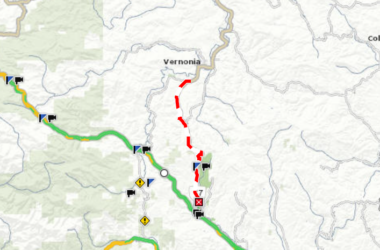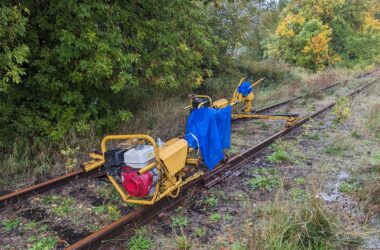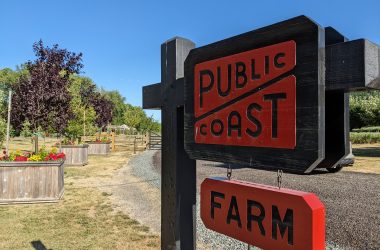U.S. Representative Suzanne Bonamici found herself in Buxton for at least the second time this year on Friday, September 8, this time touring Public Coast Farm, which has a Fisher Road address and also abuts Highway 26 to one side and the proposed Salmonberry Trail to the other.
The congresswoman was there to learn about the farm’s operations, which are sprawling, eclectic, and increasingly integrated with the other businesses owners Ryan and Stephanie Snyder run on the North Coast, including Public Coast Brewing Co., and Stephanie Inn.
There’s the blueberries—10 acres, 8 different varieties, 80,000 pounds picked a year—which can now be found in beer and hard seltzer made by the Cannon Beach-based Public Coast Brewing. There’s the honeybees buzzing about, filling their hives with fresh, Buxton wildflower honey.

The farm has hops growing alongside the still-present gravel airstrip, and a huge swath of sunflowers growing in front of a former aircraft hanger is sure to tempt any photographer driving to Seaside or Portland through the Banks region.
There’s more—a farmstand, microgreens, tomatoes with fantastically long vines growing in a greenhouse—at the farm, and more to come.

The site that is now the Public Coast Farm was the home of Portland children’s television legend Ramblin’ Rod Anders, who constructed an airstrip for his own private use on the property. After his death in 2002, the site was purchased in 2004 by Mike and Jennie Applebee who ran the controversial Apple Valley Airport out of the property.
The property was purchased in 2018 by the current owners.
Bonamici took a tour, asking questions about the farm and offering insight into programs at the congressional and federal level that could help farms like Public Coast and others tap into resources.

She mused about the possibility of places like Public Coast Farm partnering with educational institutes to teach lessons to students about agriculture.
“It’s great for kids to know where food comes from,” she said.
She touched on water rights and the difficulty some farms in Oregon have in ensuring they have an adequate supply of water to grow crops. Public Coast Farm draws water from West Fork Dairy Creek, and their only recent water difficulty came from a burned-out pump that malfunctioned during a recent thunderstorm, according to Public Coast Farm Farm Manager Antonio Rios.
In fact, where West Fork Dairy Creek runs through the farm is also under a trestle where the Port of Tillamook Bay railroad right of way touches the property, and where officials with the Salmonberry Trail Intergovernmental Agency and people involved with the nonprofit Salmonberry Trail Foundation hope to build an 80-mile-plus trail from Banks to Tillamook.

It’s another opportunity for the farm in the future, which, by all accounts has no shortage of future opportunities.
It’s that trail that found Bonamici in Buxton in June as well.
A cohort of elected officials—Congresswoman Suzanne Bonamici, Washington County District 4 Commissioner Jerry Willey and Banks Mayor Stephanie Jones—traipsed through Buxton the morning of Monday, June 26 to view the site of the proposed Salmonberry Trail.

Starting at what could become a new trailhead in Buxton near Fisher Road and Highway 47, the morning itinerary included an out-and-back along the tracks of the former Pacific Railway & Navigation Co.—owned now by the Port of Tillamook Bay—for a total of about two miles.
At the turnaround point was the Williams Creek Trestle, a massive wood structure that formerly held the weight of steam engines, tourist trains, lumber stacked on rail cars, and could, with a lot of money, be refitted to hold the less weighty hiker or cyclist in the future.

This stretch of the Salmonberry corridor neatly slices through the very edge of Oregon State Parks’ Stub Stewart State Park, which also intersects with the Banks-Vernonia State Trail, offering several tantalizing loop options starting in Banks and Manning in the future.
The Salmonberry Trail route, while recently cleared of brush from Banks to the Williams Creek Trestle, remains closed to the public.
A small trail winds from Stub Stewart State Park to the trestle, offering viewers a “look but don’t touch” viewpoint underneath the trestle at tiny Williams Creek. At the top, ankle-size gaps between the ties and unmaintained, century-old rail infrastructure could send an unwary would-be hiker to their doom.
On Monday, the aim wasn’t just to give elected officials an update on recent progress toward creating the Salmonberry Trail, but to ensure that officials would see what’s needed next for the project to succeed: Money.

“For this trail to be successful, we need not only the support and engagement of a lot of individuals—like the 1,100 volunteers that have been helping us clear the track—but also the support of elected officials, because this project is going to require big investments for things like parking lots and making this trail accessible for all,” said Salmonberry Trail Foundation Board President and Buxton resident Alison Graves.
“So being out here today feels like a big step for us in this stage of the process,” Graves said, stepping over a series of railroad ties.

While the brush has been cleared from the rail line, walking can be challenging, requiring a cadence—stepping from tie to tie to tie that frustratingly don’t always line up evenly—interrupted by the occasional stump of a small tree or crumbing creosote-soaked railroad tie.
This journalist eschewed handwritten notes, opting for an audio recording of the conversation and an eye to the ground to avoid breaking an ankle.
It’s likely the end of the line for these ties, tracks, spikes, and even the ground they lie on.
Starting this year, a salvage company is expected to begin their work, pulling up the rail infrastructure that’s marked more than a century of rail, logging, and tourist history in western Washington County and Tillamook County.
The plan had been for salvage operations to begin in August; August came and went, and now in September, Salmonberry Trail Foundation spokesperson Gavin Mahaley said the company that was tapped to pull up the rail is now slated to begin work in October.
Some of the ties and rail could be reused, finding their way into other lines across the U.S.

Some may simply be melted down for scrap; the rail is old, placed there when Teddy Roosevelt was still president, and back then, the nickel content was higher, making it a valuable metal to be reclaimed today, said John Vogler, Salmonberry Trail Foundation secretary and trail clearing coordinator.
“It’s like a several-ton doorstop,” Vogler explained, describing the rail salvage process and equipment. “They hook it with chains to a medium size backhoe, and they put the wedge down at the end of the project, and the wedge goes into the rail ballast,” he explained.
The rail, ties, and two feet of ballast is wedged right out of the ground, though it’s not all that simple: Some of the infrastructure must be cut out manually.
It’s this work that could clear the way for the next step: the creation of the Salmonberry Trail.
And it’s here why so many elected officials were invited to walk the site: Without the support of officials at the federal, state, county, and local level, the Salmonberry’s path to creation becomes increasingly tenuous.
An uptick in effort by the Salmonberry Trail Foundation and their numerous volunteers can only go so far, but a slew of fundraising efforts, grant requests, and tours like the one in June with key decision makers could mean that the Banks-Vernonia State Trail could sooner than later be joined by, and maybe to, the Salmonberry Trail.

Chas Hundley is the editor of the Banks Post and sister news publications the Gales Creek Journal and the Salmonberry Magazine. He grew up in Gales Creek and has a cat.






